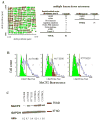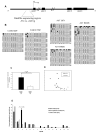Reduced MeCP2 expression is frequent in autism frontal cortex and correlates with aberrant MECP2 promoter methylation
- PMID: 17486179
- PMCID: PMC1866172
- DOI: 10.4161/epi.1.4.3514
Reduced MeCP2 expression is frequent in autism frontal cortex and correlates with aberrant MECP2 promoter methylation
Abstract
Mutations in MECP2, encoding methyl CpG binding protein 2 (MeCP2), cause most cases of Rett syndrome (RTT), an X-linked neurodevelopmental disorder. Both RTT and autism are "pervasive developmental disorders" and share a loss of social, cognitive and language skills and a gain in repetitive stereotyped behavior, following apparently normal perinatal development. Although MECP2 coding mutations are a rare cause of autism, MeCP2 expression defects were previously found in autism brain. To further study the role of MeCP2 in autism spectrum disorders (ASDs), we determined the frequency of MeCP2 expression defects in brain samples from autism and other ASDs. We also tested the hypotheses that MECP2 promoter mutations or aberrant promoter methylation correlate with reduced expression in cases of idiopathic autism. MeCP2 immunofluorescence in autism and other neurodevelopmental disorders was quantified by laser scanning cytometry and compared with control postmortem cerebral cortex samples on a large tissue microarray. A significant reduction in MeCP2 expression compared to age-matched controls was found in 11/14 autism (79%), 9/9 RTT (100%), 4/4 Angelman syndrome (100%), 3/4 Prader-Willi syndrome (75%), 3/5 Down syndrome (60%), and 2/2 attention deficit hyperactivity disorder (100%) frontal cortex samples. One autism female was heterozygous for a rare MECP2 promoter variant that correlated with reduced MeCP2 expression. A more frequent occurrence was significantly increased MECP2 promoter methylation in autism male frontal cortex compared to controls. Furthermore, percent promoter methylation of MECP2 significantly correlated with reduced MeCP2 protein expression. These results suggest that both genetic and epigenetic defects lead to reduced MeCP2 expression and may be important in the complex etiology of autism.
Figures



References
-
- Kriaucionis S, Bird A. DNA methylation and Rett syndrome. Hum Mol Genet. 2003;12:R221–227. Spec No 2. - PubMed
-
- Nicolson R, Szatmari P. Genetic neurodevelopmental influences in autistic disorder. Can J Psychiatry. 2003;48:526–537. - PubMed
-
- Lamb JA, Moore J, Bailey A, Monaco AP. Autism: recent molecular genetic advances. Hum Mol Genet. 2000;9:861–868. - PubMed
-
- Tager-Flusberg H, Joseph R, Folstein S. Current directions in research on autism. Ment Retard Dev Disabil Res Rev. 2001;7:21–29. - PubMed
-
- Amir RE, Van den Veyver IB, Wan M, Tran CQ, Francke U, Zoghbi HY. Rett syndrome is caused by mutations in X-linked MECP2 encoding methyl-CpG-binding protein 2. Nat Genet. 1999;23:185–188. - PubMed
Publication types
MeSH terms
Substances
Grants and funding
LinkOut - more resources
Full Text Sources
Other Literature Sources
